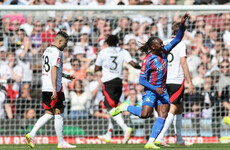WHILE THE MONSTERS around him were busy smashing each other brutally and relentlessly on Saturday in Dublin, Beauden Barrett flitted in and out of view in delightful fashion.
Invariably, his contributions to this game were of deluxe quality. Snappy kick passes to his wings, an intelligent try-saving tackle, sharp delivery from hand and so much more – Barrett lived up to his billing as the best player in the world.
While Ireland couldn’t manufacture tries despite enjoying large spells of possession and territory, the All Blacks always had a moment of magic ready to be unleashed by Barrett.
In this absorbing, wince-inducing and ferociously-fought contest, the man from the farm in between Pungarehu and Rahotu made the difference.
Cross-field class
New Zealand owned the restart battle in Dublin on Saturday, having lost out to Ireland in this area in Chicago – Rob Kearney’s take over Ben Smith was a symbol of the Irish success in Soldier Field.
Having kicked long with most of their restarts in Chicago, the All Blacks reverted to their more common strategy of dropping the ball just over the 10-metre line on Saturday.
Above, we see the very first kick-off of the game and the quality of Barrett’s delivery is obvious. His low-trajectory drop kick allows Kieran Read to chase the ball over the 10-metre line to its landing point.
Arguably, Read takes Sean O’Brien out in the air, but he is off the ground and genuinely competing for the ball in this instance, meaning the match officials are happy it’s a realistic contest.
New Zealand won three of their own restarts in this game – the sensational Brodie Retallick brilliantly claiming the other two – as they asserted their dominance in this key set-piece.
In the passage at hand, Anton Lienert-Brown snaps up the bouncing ball and the All Blacks begin an attacking sequence that only briefly stops with a superb O’Brien turnover – his first of three – before the Kiwis flood back into the Ireland half on kick return.
Barrett’s role is initially as a distributor, inviting team-mates onto the ball and getting width into the All Blacks’ game. His use of the skip pass is notable and contrasts with the perception that the Kiwis always go through each set of hands in the attacking line.
Big carries from the likes of Liam Squire and Read bring the All Blacks to within a metre of the Irish tryline after 12 phases.
Having attempted to bludgeon their way over from close-range, the All Blacks require something different for the finishing touch and Barrett is the man to provide it.
It’s a sensational kick pass from the All Blacks out-half across the field, displaying not only his excellent technique but also major composure so close to the line.
Barrett’s head is down, focusing on dropping the ball straight and connecting his right boot with it cleanly, worrying about the technique rather than the outcome. He stabs the kick low enough to beat the majority of Ireland’s defence covering across.
As important as Barrett providing such a high-quality kick is the Kiwis’ habit of holding width, even so close to the opposition tryline.
Above, we can see try-scorer Malakai Fekitoa and Julian Savea [circle in white] having held the width for New Zealand. Conor Murray [red] is sprinting hard across from a starting position just to the right of the posts.
That leaves Murray exposed and he misses Fekitoa in the tackle as the Kiwi outside centre dummies, then Payne can’t get enough contact onto the Highlanders centre to prevent him from scoring.
It’s nothing unusual for the defence to become narrow on their tryline – they have to plug up the fringes of the rucks – but many attacking teams also become narrow in this area. New Zealand, in contrast, almost always maintain their width in all areas of the field.
Not only does that allow them to score in this manner, by sending the ball wide, but it also sometimes drags the defence away from those fringe areas at the rucks and allows the All Blacks to score closer in.
Pace in place
Barrett’s own try in the 14th minute was the latest example of his startling pace, as well as a celebration of intelligent and simple set-piece attack.
The All Blacks out-half very nearly set up a try for Isreal Dagg just before his own, having delightfully chipped over the Irish defence on kick return, gathering in his kick and attempting to feed his left wing for a run-in.
This incident underlines the range of Barrett’s attacking kicking game, as well as his threat to opposition teams when returning their kicks from deep.
Lienert-Brown is signalling early [white below] to Barrett’s right that he’s picked out some space in between O’Brien and Payne, but the Kiwi out-half has spotted an even greater opportunity, one his skill set allows him to exploit.
With Ireland’s chasing line initially unable to come forward with much linespeed after a clearing kick by Rob Kearney from deep behind them that doesn’t find touch, Barrett has quite some time to calibrate the power and distance he needs on his chip.
He gathers on the bounce and immediately looks to find Dagg on his inside shoulder, but Andrew Trimble’s intercept attempt denies the Kiwis an almost certain try.
Clearly, the Ulsterman is attempting to intercept but we have seen these instances punished with penalties and yellow cards quite frequently, so he will have been relieved to see Jaco Peyper signal for a scrum instead.
However, that scrum – very close to the middle of the pitch – was no relief for Ireland collectively. Those who have watched New Zealand throughout the year understand the sheer effectiveness of their strikes from scrum platforms, and this was a hugely dangerous situation for Ireland even before the feed.
Midfield scrums are generally tough to defend. With so much space for the defence to cover – both in the frontline and the backfield – the advantage lies with the attacking team.
Let’s take a look at Ireland’s defensive set-up from the scrum in the shot above.
Johnny Sexton [10], Garry Ringrose [23] and Simon Zebo [11] are on Ireland’s left side of the scrum, but there are only two All Blacks players holding on that side in Ben Smith [15] and Dagg [14].
Why does Sexton need to be here at all?
Essentially, if Sexton starts on the other side of the scrum it’s an invitation to the All Blacks to attack to their right with an eight-nine play or something similar.
Imagine Read picking and going at Ireland on the red line above without Sexton starting in the position he does.
Read would be attacking with Aaron Smith arcing outside him [yellow] and then Ben Smith and Dagg providing the passing options as they come forward wider out [white] – even with the back row breaking it’s a huge advantage to the Kiwis.
Whatever way New Zealand would actually go about targeting that side of the scrum, the presence of Sexton essentially ensures that Ireland aren’t completely open to being attacked on that side of the scrum.
This set-up in defence is nothing out of the ordinary.
On Ireland’s right side of the scrum, they feel they are well covered too.
Scrum-half Conor Murray starts in close to the scrum and he must initially concern himself with any sniping threat from opposite number Smith or Read, but once he’s sure the pass is going, Murray is designated to deal with Barrett [as signified by red above].
Payne then drifts onto Lienert-Brown [yellow], Trimble deals with Fekitoa [white] and fullback Kearney takes the last man, Savea [blue].
With Kearney pushing up from the backfield to cover the last attacker, Sexton’s second role in this system is to sweep across from Ireland’s left and in behind the defensive line to provide a safety net and cover for kicks [as below].
Again, this is orthodox scrum defence from Ireland but there is, of course, a special element at play with the pace of Barrett.
New Zealand use channel one ball in the scrum – hooking it in between the loosehead’s legs and down the left-hand side of the scrum – to ensure rapid possession for their backline.
Indeed, as we can see above, Smith makes it even quicker set-piece possession for the Kiwis by picking the ball out of the second row, rather than from the back of the scrum at Read’s feet. Smith’s pass is excellent, straight to Barrett’s hands at speed.
This also means the All Blacks are attacking from a metre closer to the Irish defence, and their flatness is key to the score.
The Kiwis almost always start exceptionally flat on scrum attack.
We can see above that Barrett accepts Smith’s accurate pass in line with where his second rows are. Against the drifting nature of Ireland’s defence in this instance, being so flat bring great stress.
We can also see above how wide Barrett is of the scrum and that immediately places more stress on Ireland. Also note the threat of the backs outside Barrett, offering genuine options for the passing attack to his left.
Already, Ireland are in major trouble.
Barrett’s running line is excellent, as he starts square up the pitch, then turns the pace on to dart out to his left, pointing for the cornerflag.
Barrett is actually running at Payne here, echoing the Ireland outside centre’s drift across the pitch, almost tracking him towards the touchline.
This is a key part of the Kiwis’ attacking idea. They’re aware Payne is going to want to drift off to his right and they attack that drift – as well as the sheer ground Murray has to make up.
The image above gives us a clear idea of exactly how much ground Murray has to make up from the side of the scrum to get even close to Barrett.
Outside Murray, Payne probably understands that Barrett is a breaking danger on his inside shoulder. That said, it’s almost certain that Murray communicated to Payne that he was going to deal with Barrett.
‘I’ve 10,’ ‘Barrett’s mine,’ ‘I’m on ball,’ – something to that effect would have signalled to Payne that Murray was going to take Barrett.
The Ireland outside centre starts directly in line with Barrett and it’s his job to deal with the All Blacks’ out-half if Murray cannot get off the side of the scrum to cover across and defend in the line.
The system then calls for Payne to drift out onto Lienert-Brown and therefore give Ireland the chance of numbering up against the attack.
Payne’s body is pointing outwards towards the touchline from a very early stage and it’s quite clear to Barrett that the Ireland 13 is not going to turn back in and offer any tackling threat to him.
Obviously, if Payne was to turn his shoulders in, Barrett would likely respond by throwing a pass to his left and into clear space where those deeply-threatening outside backs are waiting. If Payne turns in, the overlap is clear.
The sheer difficulty of defending this situation is obvious and all of this happens in split seconds, rather than with the benefit of multiple replays and freeze-frame images.
Payne drifts off and Murray is left in a completely one-on-one situation, as he sits off slightly too much before committing to tackling.
By the time Murray does accelerate into his tackle attempt, Barrett has already moved to top pace on that subtle line and he bursts past the Ireland scrum-half, passing inches behind Payne’s back.
“We tried to run at the defender that didn’t really want to make a tackle, he wanted to push and hold, and Barrett scored his try off that,” said All Blacks head coach Steve Hansen after the game. “Fozzie [assistant head coach Ian Foster] worked on that during the week with the backs.”
It’s simple attack to exploit the defence, but Barrett’s presence and pace was key to turning the idea into a try.
We should note the poor decision from Barrett to risk not scoring the try by allowing Sexton to engage him over the tryline. It was a surprisingly foolish bit of play from Barrett that was very nearly punished.
TMO Jon Mason was content that Barrett had grounded the ball here, although the replays allow room for argument.
That said, Ireland were initially fortunate not to be penalised for Trimble’s knock-on before the scrum, while Sexton’s tackle on Barrett in the in-goal area was around the neck and could very easily have resulted in a penalty try.
These things often tend to balance themselves out, but Barrett is likely to have learned a lesson.
Offload again
Barrett threw a divine offload in Chicago to set up Ben Smith’s try in the right corner, despite the presence of four defenders around him. It was an exceptional moment of skill on an otherwise relatively quiet afternoon for the out-half, and underlined his offloading threat.
Barrett had three offloads in total at the Aviva Stadium – Lienert-Brown and Dagg threw four each – with one of them coming in the passage that sent Fekitoa over for his second try.
This Kiwi attack started with a poor kick from Ireland.
Jackson sends up the bomb from inside Ireland’s 22 but it’s slightly too long and for that reason, Trimble and Kearney don’t fully commit to chasing it as hard as they can, concerned about Ben Smith’s footwork when he catches the ball.
The All Blacks fullback finds the middle of the pitch – fending Payne and beating Henderson in the process – and the safety of a ruck involving his forwards, before his mates in the backline strike.
The Kiwis bounce back to the left and with Ireland standing off in defence against their superior numbers, the door is opened.
Barrett does superbly after accepting a pass from first receiver Dagg, again darting at the line and getting to Payne’s outside shoulder just as he releases the ball on to Lienert-Brown.
Barrett stays big after his pass, getting in a subtle bump on Payne to impede him from drifting immediately on out the line. That proves crucial in allowing Lienert-Brown to get a good carry at Payne in order to free his hands for the offload.
Before that offload, Kearney has a decision to make in the Irish defensive line.
As Barrett passes the ball, there’s a chance for Kearney to come up at Lienert-Brown, closing down the space and taking the collision to the All Blacks centre [signified by the red arrow].
However, Kearney appears to be concerned about the presence of Squire and Aaron Cruden threatening to arrive on Lienert-Brown’s outside shoulder, and he ends up sitting off and backing away to buy time [yellow].
Outside Kearney, Trimble appears eager to come up and close the time and space for the All Blacks. With Payne getting briefly bumped by Barrett, the disjoint is created and Lienerert-Brown advances into a Payne tackle that he’s able to control, offloading to Barrett – who has stayed alive and in support.
As he has done all year, Barrett then produces the touch of magic.
The sheer level of awareness from Barrett is impressive here – although it’s worth stressing again the the All Blacks’ scrum-halves always run the kind of support line TJ Perenara offers here.
Barrett doesn’t even need to really look, such is the consistency of that support.
The Kiwi out-half initially uses his right arm to shield Kearney from the ball as Ireland’s fullback goes to tackle him, then pulls that right arm through and back onto the ball to spin it away out the back of the hand to Perenara.
So comfortable in these situations, the scrum-half rapidly steps to the outside of Jackson, draws in Trimble and tucks the ball around the Ireland wing’s back to offload to the gleefully waiting Fekitoa.
Magical skills all round, but Barrett’s two touches were as prominent as any.
The Hurricanes man is simply a joy to watch and he was the difference on Saturday.
The42 is on Instagram! Tap the button below on your phone to follow us!
































Well taken goal Robbie. Good to have him fit for Estonia!
FYI, Keane’s goal celebration has been incorporated into FIFA 12, pretty cool to be able to do it with any player after scoring.